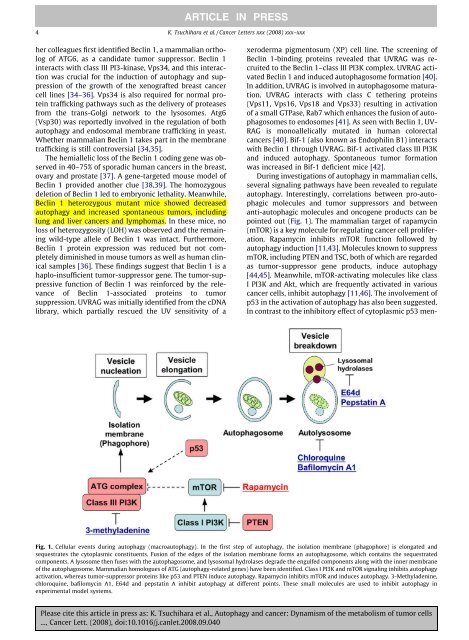Autophagy and cancer: Dynamism of the ... - ResearchGate
Autophagy and cancer: Dynamism of the ... - ResearchGate
Autophagy and cancer: Dynamism of the ... - ResearchGate
You also want an ePaper? Increase the reach of your titles
YUMPU automatically turns print PDFs into web optimized ePapers that Google loves.
ARTICLE IN PRESS4 K. Tsuchihara et al. / Cancer Letters xxx (2008) xxx–xxxher colleagues first identified Beclin 1, a mammalian ortholog<strong>of</strong> ATG6, as a c<strong>and</strong>idate tumor suppressor. Beclin 1interacts with class III PI3-kinase, Vps34, <strong>and</strong> this interactionwas crucial for <strong>the</strong> induction <strong>of</strong> autophagy <strong>and</strong> suppression<strong>of</strong> <strong>the</strong> growth <strong>of</strong> <strong>the</strong> xenografted breast <strong>cancer</strong>cell lines [34–36]. Vps34 is also required for normal proteintrafficking pathways such as <strong>the</strong> delivery <strong>of</strong> proteasesfrom <strong>the</strong> trans-Golgi network to <strong>the</strong> lysosomes. Atg6(Vsp30) was reportedly involved in <strong>the</strong> regulation <strong>of</strong> bothautophagy <strong>and</strong> endosomal membrane trafficking in yeast.Whe<strong>the</strong>r mammalian Beclin 1 takes part in <strong>the</strong> membranetrafficking is still controversial [34,35].The hemiallelic loss <strong>of</strong> <strong>the</strong> Beclin 1 coding gene was observedin 40–75% <strong>of</strong> sporadic human <strong>cancer</strong>s in <strong>the</strong> breast,ovary <strong>and</strong> prostate [37]. A gene-targeted mouse model <strong>of</strong>Beclin 1 provided ano<strong>the</strong>r clue [38,39]. The homozygousdeletion <strong>of</strong> Beclin 1 led to embryonic lethality. Meanwhile,Beclin 1 heterozygous mutant mice showed decreasedautophagy <strong>and</strong> increased spontaneous tumors, includinglung <strong>and</strong> liver <strong>cancer</strong>s <strong>and</strong> lymphomas. In <strong>the</strong>se mice, noloss <strong>of</strong> heterozygosity (LOH) was observed <strong>and</strong> <strong>the</strong> remainingwild-type allele <strong>of</strong> Beclin 1 was intact. Fur<strong>the</strong>rmore,Beclin 1 protein expression was reduced but not completelydiminished in mouse tumors as well as human clinicalsamples [36]. These findings suggest that Beclin 1 is ahaplo-insufficient tumor-suppressor gene. The tumor-suppressivefunction <strong>of</strong> Beclin 1 was reinforced by <strong>the</strong> relevance<strong>of</strong> Beclin 1-associated proteins to tumorsuppression. UVRAG was initially identified from <strong>the</strong> cDNAlibrary, which partially rescued <strong>the</strong> UV sensitivity <strong>of</strong> axeroderma pigmentosum (XP) cell line. The screening <strong>of</strong>Beclin 1-binding proteins revealed that UVRAG was recruitedto <strong>the</strong> Beclin 1–class III PI3K complex. UVRAG activatedBeclin 1 <strong>and</strong> induced autophagosome formation [40].In addition, UVRAG is involved in autophagosome maturation.UVRAG interacts with class C te<strong>the</strong>ring proteins(Vps11, Vps16, Vps18 <strong>and</strong> Vps33) resulting in activation<strong>of</strong> a small GTPase, Rab7 which enhances <strong>the</strong> fusion <strong>of</strong> autophagosomesto endosomes [41]. As seen with Beclin 1, UV-RAG is monoallelically mutated in human colorectal<strong>cancer</strong>s [40]. Bif-1 (also known as Endophilin B1) interactswith Beclin 1 through UVRAG. Bif-1 activated class III PI3K<strong>and</strong> induced autophagy. Spontaneous tumor formationwas increased in Bif-1 deficient mice [42].During investigations <strong>of</strong> autophagy in mammalian cells,several signaling pathways have been revealed to regulateautophagy. Interestingly, correlations between pro-autophagicmolecules <strong>and</strong> tumor suppressors <strong>and</strong> betweenanti-autophagic molecules <strong>and</strong> oncogene products can bepointed out (Fig. 1). The mammalian target <strong>of</strong> rapamycin(mTOR) is a key molecule for regulating <strong>cancer</strong> cell proliferation.Rapamycin inhibits mTOR function followed byautophagy induction [11,43]. Molecules known to suppressmTOR, including PTEN <strong>and</strong> TSC, both <strong>of</strong> which are regardedas tumor-suppressor gene products, induce autophagy[44,45]. Meanwhile, mTOR-activating molecules like classI PI3K <strong>and</strong> Akt, which are frequently activated in various<strong>cancer</strong> cells, inhibit autophagy [11,46]. The involvement <strong>of</strong>p53 in <strong>the</strong> activation <strong>of</strong> autophagy has also been suggested.In contrast to <strong>the</strong> inhibitory effect <strong>of</strong> cytoplasmic p53 men-Fig. 1. Cellular events during autophagy (macroautophagy). In <strong>the</strong> first step <strong>of</strong> autophagy, <strong>the</strong> isolation membrane (phagophore) is elongated <strong>and</strong>sequestrates <strong>the</strong> cytoplasmic constituents. Fusion <strong>of</strong> <strong>the</strong> edges <strong>of</strong> <strong>the</strong> isolation membrane forms an autophagosome, which contains <strong>the</strong> sequestratedcomponents. A lysosome <strong>the</strong>n fuses with <strong>the</strong> autophagosome, <strong>and</strong> lysosomal hydrolases degrade <strong>the</strong> engulfed components along with <strong>the</strong> inner membrane<strong>of</strong> <strong>the</strong> autophagosome. Mammalian homologues <strong>of</strong> ATG (autophagy-related genes) have been identified. Class I PI3K <strong>and</strong> mTOR signaling inhibits autophagyactivation, whereas tumor-suppressor proteins like p53 <strong>and</strong> PTEN induce autophagy. Rapamycin inhibits mTOR <strong>and</strong> induces autophagy. 3-Methyladenine,chloroquine, bafilomycin A1, E64d <strong>and</strong> pepstatin A inhibit autophagy at different points. These small molecules are used to inhibit autophagy inexperimental model systems.Please cite this article in press as: K. Tsuchihara et al., <strong>Autophagy</strong> <strong>and</strong> <strong>cancer</strong>: <strong>Dynamism</strong> <strong>of</strong> <strong>the</strong> metabolism <strong>of</strong> tumor cells..., Cancer Lett. (2008), doi:10.1016/j.canlet.2008.09.040


